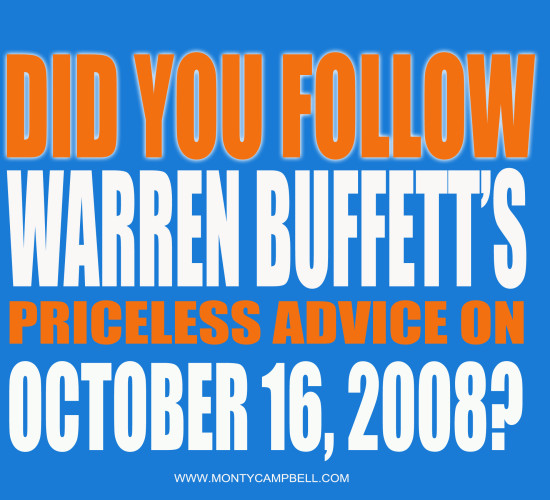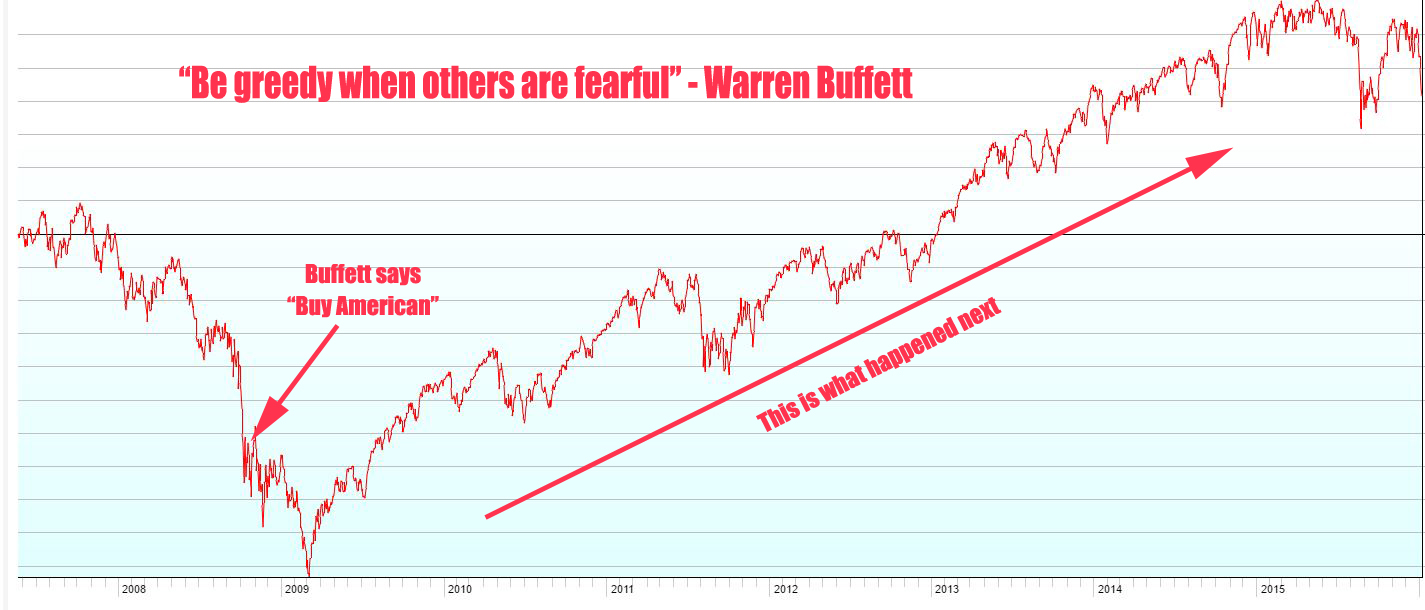Omaha.
October 16, 2008.
A date that will be forever immortalized in the investing world.
On this day, Warren Buffett pens an op-ed for the New York Times, entitled “Buy American. I Am.” You can read it here.
In the article, the billionaire said he was employing his personal investment account (outside of Berkshire Hathaway), that had previously been 100% allocated to U.S. Treasuries, into U.S. stocks. The day before the op-ed was published, the Dow fell under 10,000 for the first time in over 10 years. By February of the following year, the Dow had plummeted to its nadir of 7,062.
…before beginning an amazing comeback that has pushed it over 17,000 today!
Coincidence? Hardly.
Does Buffett have a crystal ball? Nope. Remember, the market dropped another 30% from the date he wrote that piece until finally bottoming out five months later.
So, how did he know that then was a great time to buy stocks?
Because he knew that stock prices at that level were a bargain. Buffett wasn’t saying, “here’s the bottom, buy today or else.” He was saying that things were starting to look attractive.
Margin Of Safety
And since he felt there was a margin of safety, it was time to start buying. A margin of safety refers to paying a low price compared to the true value of the company’s shares. The idea of buying when there’s a margin of safety was popularized by Buffett’s mentor Ben Graham.
But if successful investing was just as easy as buying when there’s a significant margin of safety, why doesn’t everyone do it?
Good question and here’s the answer…
There’s an oft-held theory in academia and in some investing circles that the market is efficient – that there really is no difference between a stock’s price and the value of the underlying business on a per share basis. If markets are efficient as many in academia claim (read about efficient market theory here), then prices are good estimates of value, right?
Wrong. Completely wrong. Dead wrong.
Smart investors laugh at the efficient markets theory. Charlie Munger has even gone as far to label it “twaddle” and “gibberish.”
Here’s why…
The efficient market theory claims that it’s impossible to beat the market because all investors have all relevant and available information. According to the theory, stocks always trade at their fair value on stock exchanges, making it impossible for investors to either purchase stocks at a bargain or to sell stocks for inflated prices. As such, it should be impossible to outperform the overall market through specific stock selection.
The problem with this theory is this – although all investors have all relevant and available information, how they react to that information varies greatly. Sometimes it varies wildly.
When the price of a stock can be influenced by the “herd mentality” with prices influenced by the most emotional person, or the greediest person, or even the most depressed person, it is hard to argue that the market always prices stocks rationally and efficiently. In fact, market prices are frequently irrational and inefficient.
Buying Dollar Bills For 40 Cents
This is because the average investor gets the whole “risk/reward” idea of investing completely backwards, especially when there’s huge selloffs in the market like there was in 2008-2009. Here’s Buffett on this:
“I would like to say one important thing about risk and reward. Sometimes risk and reward are correlated in a positive fashion. If someone were to say to me, “I have here a six-shooter and I have slipped one cartridge into it. Why don’t you just spin it and pull it once? If you survive, I will give you $1 million.” I would decline — perhaps stating that $1 million is not enough. Then he might offer me $5 million to pull the trigger twice — now that would be a positive correlation between risk and reward!
The exact opposite is true with value investing. If you buy a dollar bill for 60 cents, it’s riskier than if you buy a dollar bill for 40 cents, but the expectation of reward is greater in the latter case. The greater the potential for reward in the value portfolio, the less risk there is.”
You see, when Buffett wrote the New York Times piece, dollar bills were selling for 10 cents…but strangely not many people wanted to buy them. They listened to the doom and gloom prognosticators on TV telling them that the end of the “financial” world was near. This nonsense kept them on the sidelines in arguably one of the best stock buying opportunities in decades.
I write this to say that there will be times in the future when you could make many very good arguments to not go near stocks at that particular moment, just as you may have done in 2008-2009. The thing is, there are always going to be good reasons not buy something when it’s underperforming or suffering a large drawdown. Stocks don’t become cheap or fall for no reason.
This is why value investing can be so difficult. You’re going against the current and into the carnage. But to get what most don’t have, you must be willing to do what most won’t do. And that’s not a statement of bravado, just one of rational thinking. You see, markets reward patience and a contrarian view. Here’s Buffett again:
A simple rule dictates my buying: Be fearful when others are greedy, and be greedy when others are fearful. And most certainly, fear is now widespread, gripping even seasoned investors. To be sure, investors are right to be wary of highly leveraged entities or businesses in weak competitive positions. But fears regarding the long-term prosperity of the nation’s many sound companies make no sense. These businesses will indeed suffer earnings hiccups, as they always have. But most major companies will be setting new profit records 5, 10 and 20 years from now.
Let me be clear on one point: I can’t predict the short-term movements of the stock market. I haven’t the faintest idea as to whether stocks will be higher or lower a month – or a year – from now. What is likely, however, is that the market will move higher, perhaps substantially so, well before either sentiment or the economy turns up. So if you wait for the robins, spring will be over.”
When every type of investment is going down, it is hard for the average investor to keep his wits about him. Nobody wants to buy their dream beach house when the housing market is terrible. But that’s exactly the time to buy because it offers the best prices. The same is true in the equity markets.
Intelligent investors will recognize down markets for what many really are – a great buying opportunity! Most people will follow the crowd and try to sell during the worst time to sell, but others who’ve done their homework will profit.
Millionaires Are Made In Bad Economies
More millionaires were made during the great depression than at any other time in history to that point, in spite of the suffering of the majority of people. To make an emotional decision to sell along with everyone else is a mistake. Markets rebound. This is a fact. Here’s another fact – markets don’t lose your money. Only you can lose your money by making an emotional decision with your investments during those fluctuations.
Look, we are bred to worry. It’s in our genes to get anxious. When we see everyone stampeding towards the door, we want to follow suit.
We’re all familiar with this idea of fight or flight. When we believe we can beat the enemy, we fight. When the odds are against us, we take off.
This is pure instinct.
But remember this, there’s no such thing as “fighting” the market. Success in the stock market is not about sheer strength or power. It’s about patience and doing your homework. It’s about temperament. It’s having the courage and intelligence not to run at the exact moment you should be buying. That’s how money is made in the market.
And it’s always been that way…
In 1871 when the Commune in Paris was at its height and the streets were red with blood, a young man called on the great banking firm of Baron Rothschild to ask advice about a large fortune to which he had become heir. The head of the house told him to buy French Government Securities. “What: buy securities when the streets of Paris are running with blood!” was the young man’s surprised exclamation. Baron Rothschild is reported to have said: “My young friend, that is the very reason that today you can buy securities for 50% of their face value.” This led to the oft-quoted adage “Buy when there’s blood in the street.”
Investment opportunities are presented to you at exactly the time you are least emotionally prepared to accept them. That is precisely why they exist. Fortunately, investment opportunities do not require actual blood to be spilled. Far less dramatic opportunities are presented every day. And the world’s greatest investors, in fact “The World’s Greatest Investor,” regularly employs the idea of being greedy when others are fearful. Shouldn’t you?
Be free. Nothing else is worth it.
Latest tweets from Monty!
“You will not survive the middle class. The top 1% of U.S. households now control 42% of the nation’s wealth. Be free or suffer mediocrity.”
“Biggest regret many have late in life? Not becoming all that they could have been, a wasted life. Take achieving your potential personally.”
“There’s something that you need to do in life & chances are, it’s not the work at your job. Wealth provides freedom to do what you must do.”
Check-out Monty’s Instagram page!
Ready for more tips on how to achieve the free life? Check-out these articles from the blog archives:
The Evolution Of A Billionaire: How Warren Buffett Made His First Billion Dollars!
Infographic: 10 Great Quotes From Warren Buffett To Memorize, If You Want To Win At Investing!
The Best Of 2015: The 10 Most Popular Financial Freedom Articles Of The Year!





